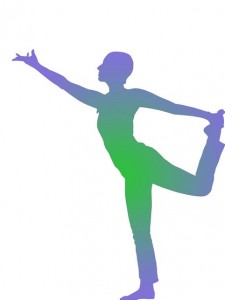It is well accepted that yoga is a great tool for countering stress. Yoga helps calm the mind body down and de-stress it. But how does it work? To understand this we need to know what Biofeedback is.
Biofeedback
Biofeedback is a technique that is used to train people with conditions such as high blood pressure, headache, migraine, chronic pain, and urinary inconsistence. Biofeedback is generally used to control bodily processes that are not normally in our voluntary control. Electrodes are attached to our skin to measure heart rate, brain waves, skin temperature, skin moisture, stress in muscles, etc., The information collected by the various instruments is processed and displayed to the patient as a signal, usually on a monitor. This signal usually represents the stress levels of a patient. The patient is asked to mentally work towards moving the signal in a particular direction that indicates lowering of stress level. Biofeedback allows the patient to understand her current stress levels and figure out what thoughts and actions increase it and what lower it, allowing her to voluntarily control her stress levels. When this happens blood pressure reduces, muscles relax and chronic pain subsides.
Biofeedback shows that it is possible to voluntarily reduce stress levels by countering its effects.
Impact Of Stress On Us
Here is what stress does to us:
1. It makes our muscles tense.
2. It shortens our breath making it shallow and quick.
3. It puts our mind in a tizzy of circular thoughts of worry and anxiety.
This means that if we counter each of these effects of stress, we should be able to trigger a response from our body that de-stresses it.
Does It Really Happen?
The fact that meditation triggers relaxation has been scientifically established since the past 40 years. This effect is well known as the “Relaxation Response”. If we interrupt the constant flow of thoughts in our heads by repeating a single thought or phrase for 20 minutes, our body triggers a “Relaxation Response”. This causes our body to relax muscles, lower blood pressure, slow down breathing, and de-stress.
The following effects have also been tested and scientifically established to various degrees:
1. If we stretch our muscles for 20 to 30 minutes then this triggers a response in our body that is equivalent to de-stressing.
2. If we breathe consciously for 10 to 15 minutes to slow and elongate our breath then this too triggers a relaxation response in our body and de-stresses it.
Yoga’s Triple Whammy De-stressing
Yoga is an extremely powerful de-stressor because it takes advantage of all three mechanisms to counter stress:
1. Most of yoga’s postures involve stretching various muscle groups. By systematically stretching muscles we send a strong biofeedback signal to our mind-body to relax and de-stress.
2. While practicing yoga postures the breath is deliberately slowed down and elongated. A specific technique of breathing known as “Ujjayi breath” (Throat Breath or Ocean sounding breath) is used to accomplish this. And it provides a great biofeedback signal for our mind-body to relax.
3. Yoga practitioners are asked to focus all thoughts only on breath and movement. Advanced practitioners are required to have a “focused gaze” known as “Drishti”. All this ensures that the mind is not wandering while practicing yoga. By breaking the cycle of circular thoughts of anxiety and worry the body is put in a relaxed state.
Because yoga uses all three powerful techniques at the same time, it provides a strong biofeedback for our mind-body to relax and de-stress. The effect is usually so powerful that yoga practitioners attest to feelings of floating, peace, and calmness after the practice is over. Yoga is currently the only known mass used technique that allows a systematic way to counter chronic stress. Since chronic stress is the underlying cause of so many of our physical and mental ailments, the effects of yoga are so “magical”.
Yoga Cautions
Smoking is extraordinarily dangerous and it slowly kills us. But many of us are unable to kick the habit because smoking is addictive. Similarly stress too is extraordinarily dangerous for us and chronic stress is a silent killer. But just as it is difficult to kick the habit of smoking, it is also difficult to counter chronic stress because it too is addictive.
So, as we do yoga to counter the effect of stress, many of us somehow reintroduce stress in our lives in various forms. It is important to recognize this and counter this tendency. This is why the larger practice of yoga involves simplification and slowing down our lives. The benefits of yoga can easily be lost if we do not look at the big picture of our lives.
Sometimes we do not have to go too far to see how the dilution of the benefits of yoga is accomplished. This is done within the yoga practice itself. Yoga is sometimes practiced as a “fast workout” incorporating fast music. As we have seen the benefits of yoga happen by:
1. Stretching muscles not contracting them.
2. By slowing and elongating the breath, not shortening and quickening it.
3. By focusing our thoughts and calming down the mind, not exciting it.
Please make sure that your yoga practice delivers to you its main benefit: de-stressing of the mind-body.
The Gift Of Yoga
Yoga is an extraordinary gift. It is one of the few available scientifically proven ways of countering chronic stress. It is inexpensive, needs no fancy equipment, and is practiced safely and effectively by millions. Compared to the cost of chronic stress on our lives, yoga is safe, cheap, and effective. Let us resolve to maximize the gift of yoga by also looking at the big picture of our lives. And also let us make sure that the yoga we practice delivers on the main benefit in terms of de-stressing our mind-bodies.
Related: Five Golden Rules For Beginners
Credits:This has been written by Raj Shah and edited by Ketna Shah.

